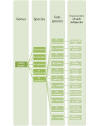Navigation
Phylogeny

(Click on the image to view the phylogenetic tree.)
The phylogenetic tree above is based off of 1.35 kb of mtDNA
sequence from fossils of Canadian geese (highlighted), Hawaiian
geese, and other members of the genus Branta. The
Canadian geese diverged dramatically and were found to be
paraphyletic. In order to test the DNA sequences, researchers
radiocarbon-dated collagen from the bones of the geese. They
found that the Branta split from the genus Anser
approximately 4.5 million years ago. The Canadian geese are
placed where they are because the B. sandvicensis
subspecies and the Giant Hawaii Goose are larger than
B. canadensis. Also, the B. leucopsis, B.
bernicla subspecies and B. ruficollis are
smaller than the Canadian geese subspecies.
For more information about this phylogenetic tree and how
researchers obtained this information, please visit
this website.

(Click on the image to see the subspecies phylogenetic tree.)
Under the species Branta canadensis there are eleven subspecies that differ in size, body proportion, where they reside, and how well they are able to fly. The tree above shows how the subspecies are different based on where they reproduce and to where they migrate. Under the characteristics of subspecies column, the first place mentioned is where the subspecies reproduces and the second place is where they migrate to for winter. This is the main way to differentiate between the different subspecies.
Interested in learning about the habitat of Canadian geese?
Click here.
Return home.